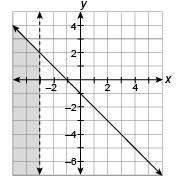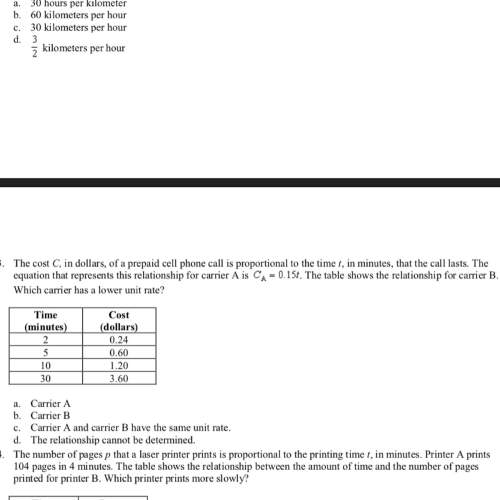
Mathematics, 15.10.2019 21:20 Johnson926
Which system of linear inequalities is graphed?
a {x< −3y≤−x+1
b {x< −3y≤−x−1
c{x≤−3y≤−x−3
d{x< −2y≤−x−1


Answers: 2


Another question on Mathematics

Mathematics, 21.06.2019 18:20
What is the solution set of the quadratic inequality x2- 5< 0? o {xl-55x55{x- 155x55){xl -55x5 15){x1 - 15 sx5/5)
Answers: 2

Mathematics, 22.06.2019 01:30
In 2000, for a certain region, 27.1% of incoming college freshman characterized their political views as liberal, 23.1% as moderate, and 49.8% as conservative. for this year, a random sample of 400 incoming college freshman yielded the frequency distribution for political views shown below. a. determine the mode of the data. b. decide whether it would be appropriate to use either the mean or the median as a measure of center. explain your answer. political view frequency liberal 118 moderate 98 conservative 184 a. choose the correct answer below. select all that apply. a. the mode is moderate. b. the mode is liberal. c. the mode is conservative. d. there is no mode.
Answers: 1

Mathematics, 22.06.2019 04:00
Un used xx milliliters, or 90\%90%, of his favorite bottle of hot sauce. which of the following expressions could represent the volume of a full bottle of jun's favorite hot sauce, in milliliters? choose 2 answers: choose 2 answers: (choice a) a \dfrac{x}{0.9} 0.9 x (choice b) b \dfrac{10}{9}x 9 10 x (choice c) c 0.9x0.9x (choice d) d xx (choice e) e x+0.1x+0.1
Answers: 2

Mathematics, 22.06.2019 07:50
Assume the population consists of the values 1, 3, 14. assume samples of 2 values are randomly selected with replacement (see page 23 for a definition) from this population. all the samples of n=2 with replacement are 1 and 1, 1 and 3, 1 and 14, 3 and 1, 3 and 3, 3 and 14, 14 and 1, 14 and 3, and 14 and 14. for part a) of this project, find the variance σ2 of the population {1, 3, 14}. for part b) of this project, list the 9 different possible samples of 2 values selected with replacement, then find sample variance s2 (which includes division by n-1) for each of them, and finally find the mean of the sample variances s2. for part c), for each of the 9 different samples of 2 values selected with replacement, find the variance by treating each sample as if it is a population (using the formula for population variance, which includes division by n), then find the mean of those population variances. for part d), which approach results in values that are better estimates of σ2 from part a): part b) or part c)? why? when computing variances of samples, should you use division by n or n-1? upload your answers for a), b), c), and d). the preceding parts show that s2 is an unbiased estimator of σ2. is s and unbiased estimator of σ? the above problem is from triola’s essentials of statistics, 4th edition.
Answers: 2
You know the right answer?
Which system of linear inequalities is graphed?
a {x< −3y≤−x+1
b {x< −3y≤−x...
a {x< −3y≤−x+1
b {x< −3y≤−x...
Questions

Biology, 24.06.2019 13:00

Computers and Technology, 24.06.2019 13:00

Mathematics, 24.06.2019 13:00







Mathematics, 24.06.2019 13:00








Computers and Technology, 24.06.2019 13:00






